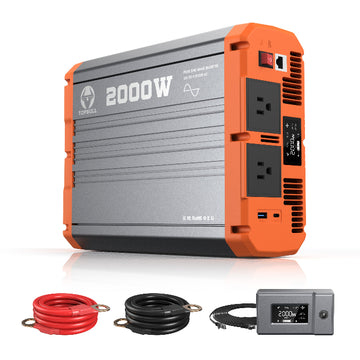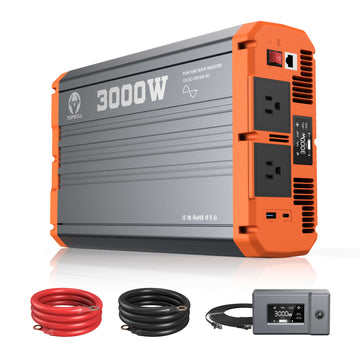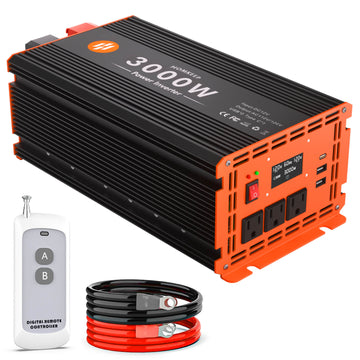Whether for outdoor camping, power outage emergency, or car office, the inverter is the “bridge” that converts the battery DC power into the AC power needed by the equipment. But battery life anxiety is always a headache: cell phones are not yet full, refrigerators alarm just after startup, and even inverters suddenly go on strike. ...... How long can a battery-powered inverter last? This article will explore this issue in depth, revealing how to scientifically match the power of the equipment, optimize load management, and then maximize the efficiency of power supply!
What factors affect runtime
The amount of time a power inverter can run on batteries is affected by a variety of factors, including:
Battery capacity (Ah)
Battery capacity is a measure of how much power a battery can store. In general, the higher the battery capacity, the longer the inverter will be able to run. For example, a 100Ah battery will be able to provide a longer runtime at the same load compared to a 50Ah battery.
Load Power (W)
Load power is the electrical power consumed by the device. If the load power is greater than the output power of the inverter or the output capacity of the batteries, the device will not operate properly or the runtime will be much shorter. For example, a 500W load will drain the batteries faster compared to a 100W load.
Inverter Efficiency (%)
The efficiency of an inverter in converting DC to AC power affects battery runtime. Most inverters have an efficiency of about 80% to 90%, which means that only a portion of the input energy is converted into useful output energy. Therefore, the more efficient the inverter, the longer the battery will run. For example, an inverter with a 90% efficiency will be able to utilize the battery's power more efficiently compared to an inverter with an 80% efficiency.
Battery Discharge Depth
Batteries should not be fully discharged during use as this will affect their life and performance. Generally, batteries can only be used for about 80% of their capacity. Therefore, the depth of discharge of the battery needs to be considered when calculating battery runtime.
Inverter type and performance
Different types of inverters (e.g., pure sine wave inverters and modified sine wave inverters) have different efficiency and performance characteristics. Pure sine wave inverters are more efficient and suitable for high power loads, while modified sine wave inverters are suitable for simple electronics and low power loads. In addition, the inverter's starting voltage threshold, size, and degree of aging can affect its performance and battery runtime.
Environmental Factors
Environmental factors (e.g., temperature, humidity, etc.) can also have an impact on battery and inverter performance. For example, high-temperature environments can accelerate the aging process of batteries, reducing their capacity and life; while humid environments can lead to failures such as moisture and short-circuiting of internal components of the inverter.
Handy calculation: how many hours can your device last?
To calculate how many hours a device can run on combined inverter and Battery Bank power, we can use a simple formula: Runtime (hours) = Battery capacity (Wh) ÷ Device power (W).
Below is the detailed calculation process and its considerations.
1. Calculating Battery Capacity
Suppose we use a 12V, 100Ah battery. First, we can calculate the total energy of the battery by the product of voltage and capacity:
Battery capacity (Wh)=12V×100Ah=1200Wh
2. Estimate the ideal running time
Under the ideal state of a fully charged battery, assume that the power of the device powered by the inverter is 300 W. Based on the above formula, we can derive the runtime as:
Running time = 1200Wh/300W = 4 hours
This means that, in this case, the battery will be able to support a 300W device for about 4 hours.
3. Practical considerations
However, in practice, two important factors need to be considered: depth of discharge and inverter efficiency. In order to ensure the health and longevity of the battery, generally speaking, the battery can only be used at about 80% of its capacity. Based on this depth of discharge, the available battery capacity is calculated as follows:
Available battery capacity (Wh) = 1200Wh x 0.8 = 960Wh
Assuming that the efficiency of the inverter is 90%, we can calculate the actual power available:
Actual available power (Wh)=960Wh×0.9=864Wh
4. Recalculate the running time
Based on the actual available power, we can calculate the running time again, using the power of the device 300W:
Running time = 864Wh/300W≈2.88 hours.
By taking into account the actual depth of discharge and the efficiency of the inverter, we arrive at a result that reflects the actual usage of the battery: at a depth of discharge of 80%, the inverter is able to support a 300W device for approximately 2.88 hours. This example calculation demonstrates how a more accurate estimate of inverter runtime can be made by reasonably evaluating practical factors.
12V Battery Runtime Quick Check Chart
The following is a quick checklist of operating hours for common vehicle/camping loads utilizing a combination of battery + inverter power:
|
Battery Capacity |
Load Power | Typical Equipment | Equipment Description | Lead Acid Battery | LiFePO4 battery |
|
12V 50Ah |
20W | Car Monitor + GPS | 24/7 operation | 10.6h | 19.1h |
| 12V 80Ah | 60W | Car Fridge | Nominal 30% | 5.1h | 9.2h |
| 12V 100Ah | 80W | roof-mounted AC | Inductive load × 0.7 | 4.2h | 12.1h |
| 12V 100Ah | 150W | 12V DC Fridge + LED Lighting | 24-hour cycle power supply | 5.7h | 16.3h |
| 12V 120Ah | 300W | Car Air Compressor | Work 10 min/hour | 1.7h | 3.0h |
| 12V 150Ah | 500W | Small electric oven | Resistive loads | 1.3h | 2.4h |
| 12V 200Ah | 800W | Car electric winch | Instantaneous power up to 2000W | 0.9h | 1.6h |
| 12V 300Ah | 800W | Microwaves | ≤10 minutes per use | 1.1h | 3.2h |
| 12V 300Ah | 1200W | RV Parking AC | Night Low ≈ 800W | 0.8h | 1.5h |
| 12V 400Ah | 1200W |
induction cooker |
Persistent high fever | 1.4h | 3.8h |
| 12V 400Ah | 2000W | Emergency welders | Work cycle 35% | 0.7h | 1.2h |
This calculation is based on pure sine wave inverter (conversion efficiency 90%), using lead-acid batteries 50% discharge depth and LiFePO4 battery 90% discharge depth industry safety standards, with the continuous operation of the equipment power as the reference value (shock loads need to be superimposed on the correction factor). System set lead-acid battery voltage protection threshold ≥ 11.8V, LiFePO4 battery ≥ 12.0V, to prevent over-discharge damage to battery life. All data include line loss and temperature drift, applicable to -10 ℃ to 40 ℃ environmental conditions.
Measures to extend inverter runtime
1. Selection of high-efficiency inverters
- The efficiency of an inverter directly affects its runtime. Selecting an inverter with high conversion efficiency reduces energy loss and thus extends the runtime.
- Pure sine wave inverters have higher efficiency and better performance compared to modified sine wave inverters, and are suitable for equipment with high power quality requirements.
2. Increase battery capacity
- The larger the battery capacity, the longer the inverter can run. Selecting batteries with the appropriate capacity based on actual needs can significantly extend the operating time of the inverter.
- Consider using deep-cycle batteries, which are designed for frequent charging and discharging and have a longer life and higher capacity.
3. Reduce load power
- Reducing the number of devices connected to the inverter or lowering the power consumption of the devices can reduce the load on the inverter and extend runtime.
- Prioritize the use of low-power devices and avoid running high-power devices at the same time.
4. Regular maintenance and inspection
- By regularly maintaining and checking the batteries and inverters, you can effectively extend the service life of the equipment and ensure the stability and efficiency of the system. Keeping batteries and inverters in good condition not only improves uptime, but also reduces the risk of malfunctions and improves the overall experience.
Battery and Inverter Configuration Strategies for Different Scenarios

Home emergency power supply scenarios
When there is a sudden power outage in the home, it is necessary to ensure the continuous operation of critical equipment such as medical equipment, routers, and refrigerators. At this time, we should choose a high-capacity Battery Bank (e.g., 12V 290Ah Li-ion Battery Bank) with a high-power pure sine wave inverter (3000W inverter), and plan the load prioritization. For example, prioritize the protection of core equipment such as ventilators and routers, and reasonably allocate secondary loads such as refrigerators and lighting. Daytime charging can be realized by adding solar panels, which significantly extends the endurance time. Measurement data shows that the configuration of 500W photovoltaic panels generates an average of 2.5kWh of power per day, which can extend the endurance time from 15 hours to 20 hours.
Outdoor camping power supply scenario
Outdoor camping pursues lightweight and portability, and needs to meet the power needs of projectors, electric skillets and other equipment. It is recommended to use 12V 50Ah Li-ion battery with 2000W pure sine wave inverter, and connect the car refrigerator through DC direct supply mode to reduce loss. Time-sharing power supply strategy can optimize the range, such as concentrating on using the electric grill for 1 hour and allocating the rest of the time for the projector and stereo. With 200W solar panel daytime charging for 2.5 hours, it can replenish 500Wh power. Actual tests show that this configuration can meet basic entertainment needs for about 3 hours, and insulation measures (such as battery compartment heating pads) can improve performance in low-temperature environments.
In-vehicle mobile office scenario
Vehicle-mounted office needs to be powered by the cigarette lighter to ensure the stable operation of laptops, cell phones and other devices. It is recommended to choose 300W car inverter, and strictly control the load power to avoid the simultaneous use of printers and other high-power devices. Voltage protection points (lead-acid batteries ≥ 11.5V, lithium batteries ≥ 12V) need to be set to prevent battery over-discharge. Measurements show that the configuration can support 60W laptop and 65W cell phone fast charging at the same time, but it is recommended to avoid prolonged high load use when the vehicle is off to prevent overloading of the electrical system.
Summarize
Understanding how to calculate the running time of a power inverter on batteries can help us better plan and use power. When using an inverter, reasonable consideration of the battery capacity, equipment power and the above mentioned influencing factors can greatly improve the efficiency of power usage and prolong the usage time. For users who often need to use inverters, it is very important to choose a high-quality inverter (such as Topbull high-efficiency inverters) and carry out proper maintenance, to learn more about the parameters of high-quality inverters, please click to view the details of the store's inverter products.













